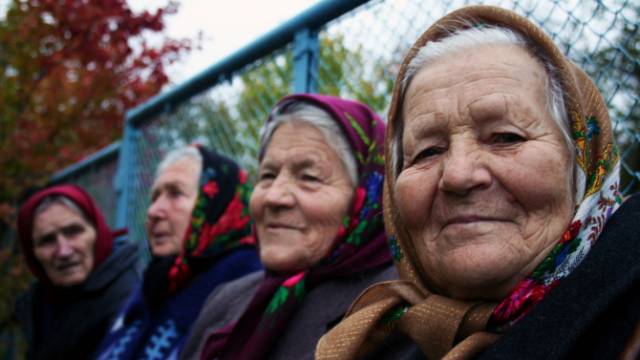
 Co-directors Holly Morris and Anne Bogart’s Kickstarter-backed film shows none of the horrific deformations that mainstream media covered following 1986’s Chernobyl nuclear reactor explosion. Rather, The Babushkas of Chernobyl is an important and inspiring testament to what can endure in a destructive world. With lovely tenderness and wit, the film focuses on three old women who self-settled back within the still highly radioactive Exclusion Zone. These old babushkas survived the starvation-genocide of the Holodomor, the Nazis, and more -- defying authority after being ordered to permanently relocate from their ancestral homes.
Co-directors Holly Morris and Anne Bogart’s Kickstarter-backed film shows none of the horrific deformations that mainstream media covered following 1986’s Chernobyl nuclear reactor explosion. Rather, The Babushkas of Chernobyl is an important and inspiring testament to what can endure in a destructive world. With lovely tenderness and wit, the film focuses on three old women who self-settled back within the still highly radioactive Exclusion Zone. These old babushkas survived the starvation-genocide of the Holodomor, the Nazis, and more -- defying authority after being ordered to permanently relocate from their ancestral homes.
The film poses to us a mystery: How have these old women happily outlived those who reside outside the radioactive zone, often by more than a decade? Being invited into their homes, listening to the details of their lives, we become like their own grandchildren hearing this cautionary tale. For we who live in a post-Fukushima world have much to learn.
There are about 200 babushkas living within the Exclusion Zone. With their stout frames and sweet faces donning varied yet nearly-identical headscarves, babushkas have been synonymous with cuteness. Their faithful adherence to tradition, in appearance and taste (they do somewhat resemble Russian stacking dolls!), is in itself endearing. However, go deeper, as these are the women who must be reckoned with if you want to survive. Strong-chinned Hanna Zavorotnya, who lovingly attends to the graves of her family, insists she’s healthier than her friends who live in Kiev. Maria Shovkuta is a wiley, feisty little lady who once lied about digging under barbed wire to return to her homeland. Behind Valentyna Ivanivna’s self-mocking songs, lies a remarkable wisdom and knowledge of the healing power of herbs.
There’s much in the film that’s about devotion. We learn the little-known side-story of today’s new generation of covert “Stalkers” who sneak their way into the forbidden zone. Like the babushkas, it’s devotion that drives them. The camouflaged young rebels are like pilgrims risking their lives to honor the relics of post-apocalyptic remains.
Later in the film, a modern older woman lab technician, possibly near babushka-age, poses an interesting contrast to the headscarf-donning grandmothers. “It’s just their ignorance and simple lack of knowledge,” she says about the old women living on the contaminated land. No babushka, she.
The film takes place during the 25th anniversary of the disaster, ironically during the month of Easter. Easter is the holiest time of the Ukrainian year. It’s why the babushkas greet each other with “Christ is risen!” Acts of devotion and triumph of life over death resonate throughout the film — whether this was intentional or not is uncertain. Still, in her TED talk about filming for three years in Chernobyl, Holly Morris observes: “The dead zone, it turns out, is full of life.”